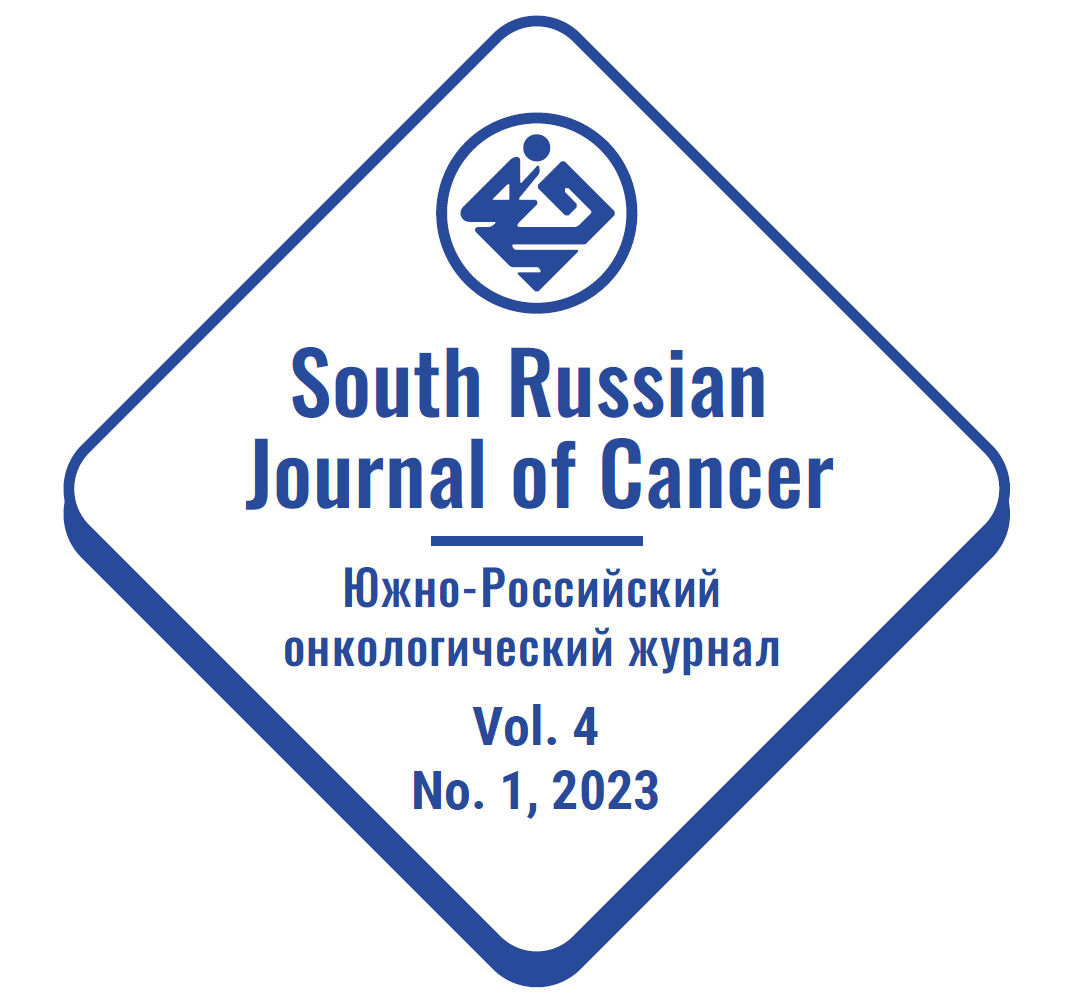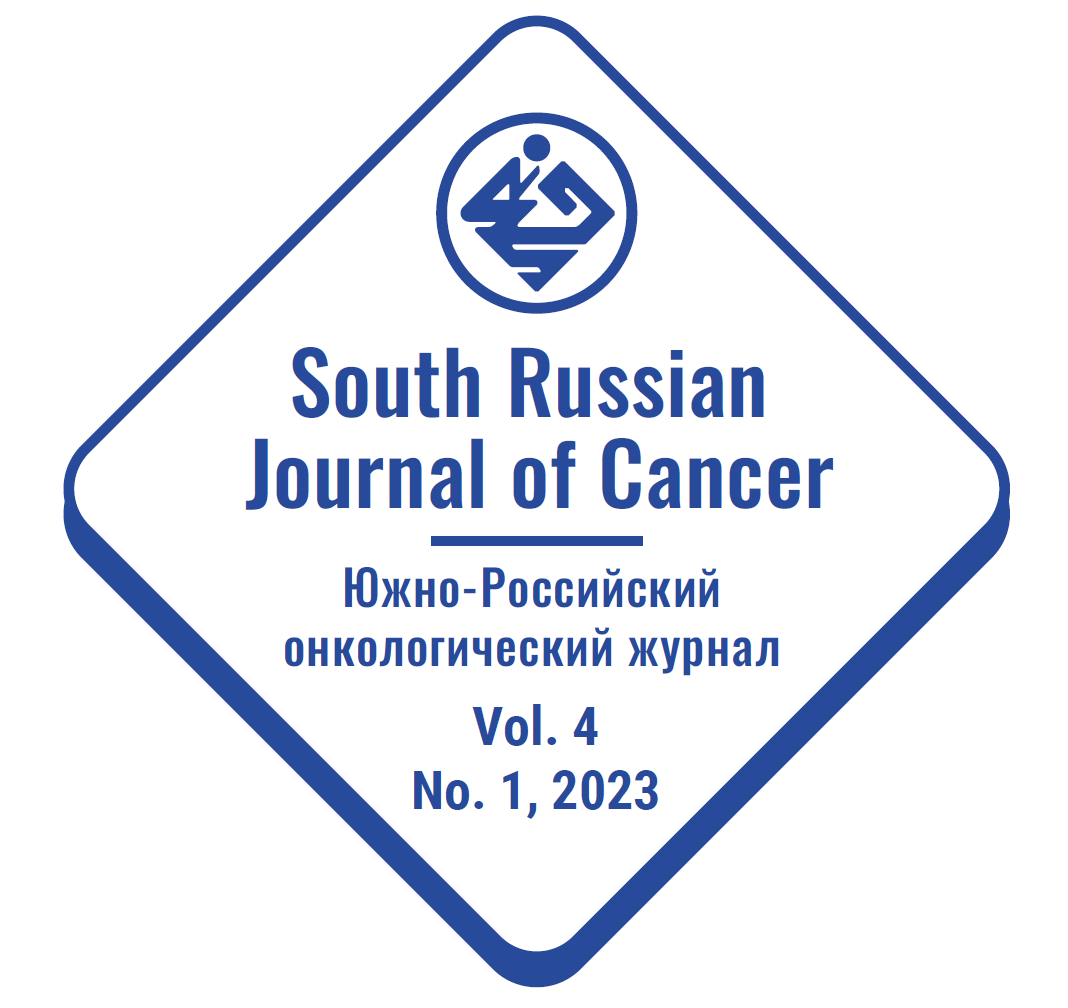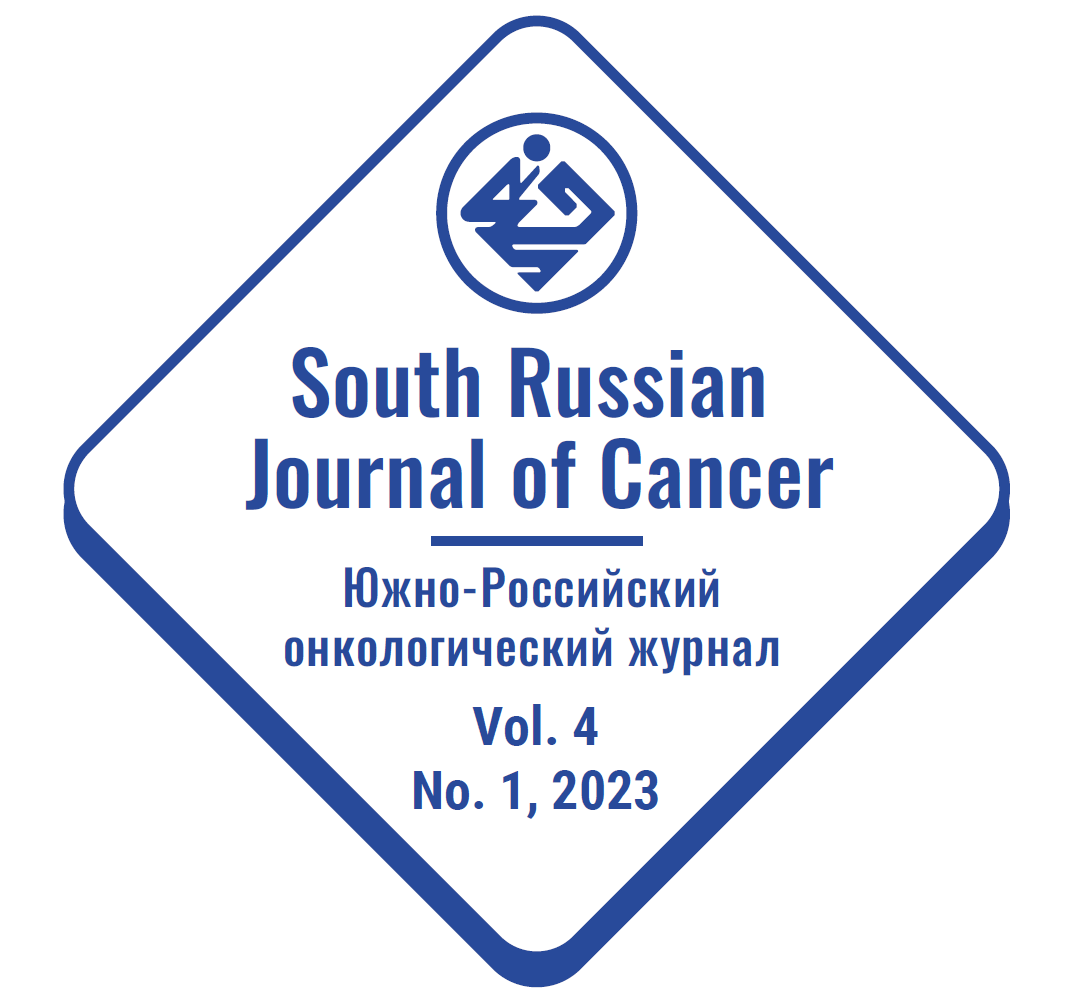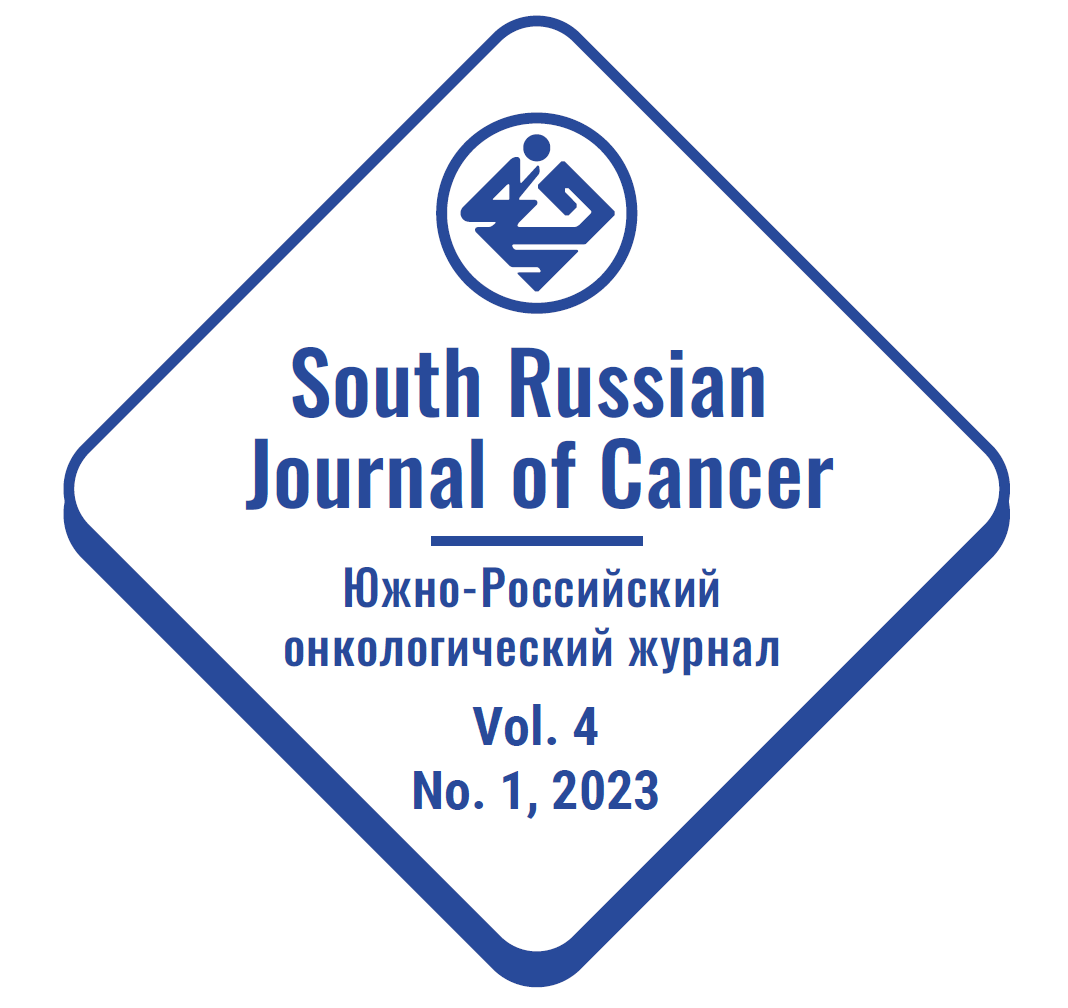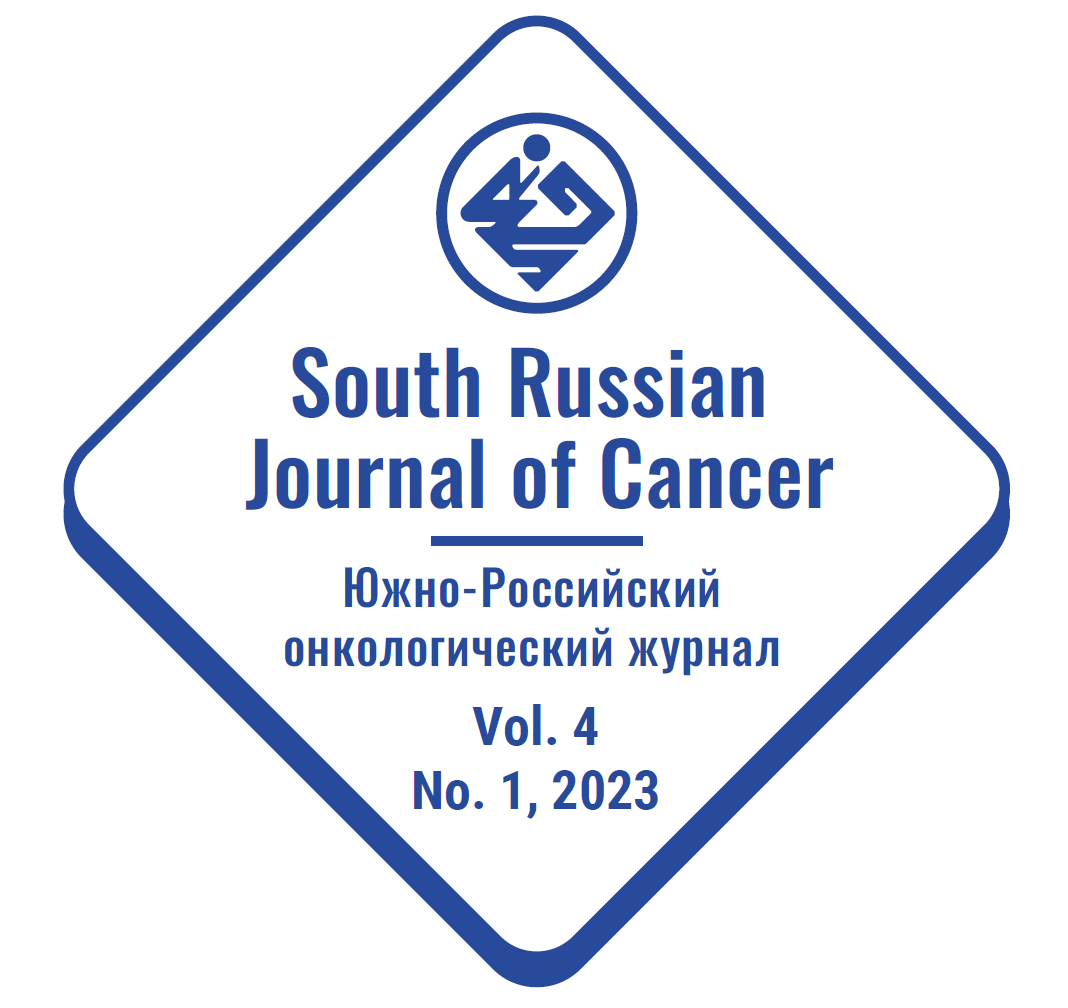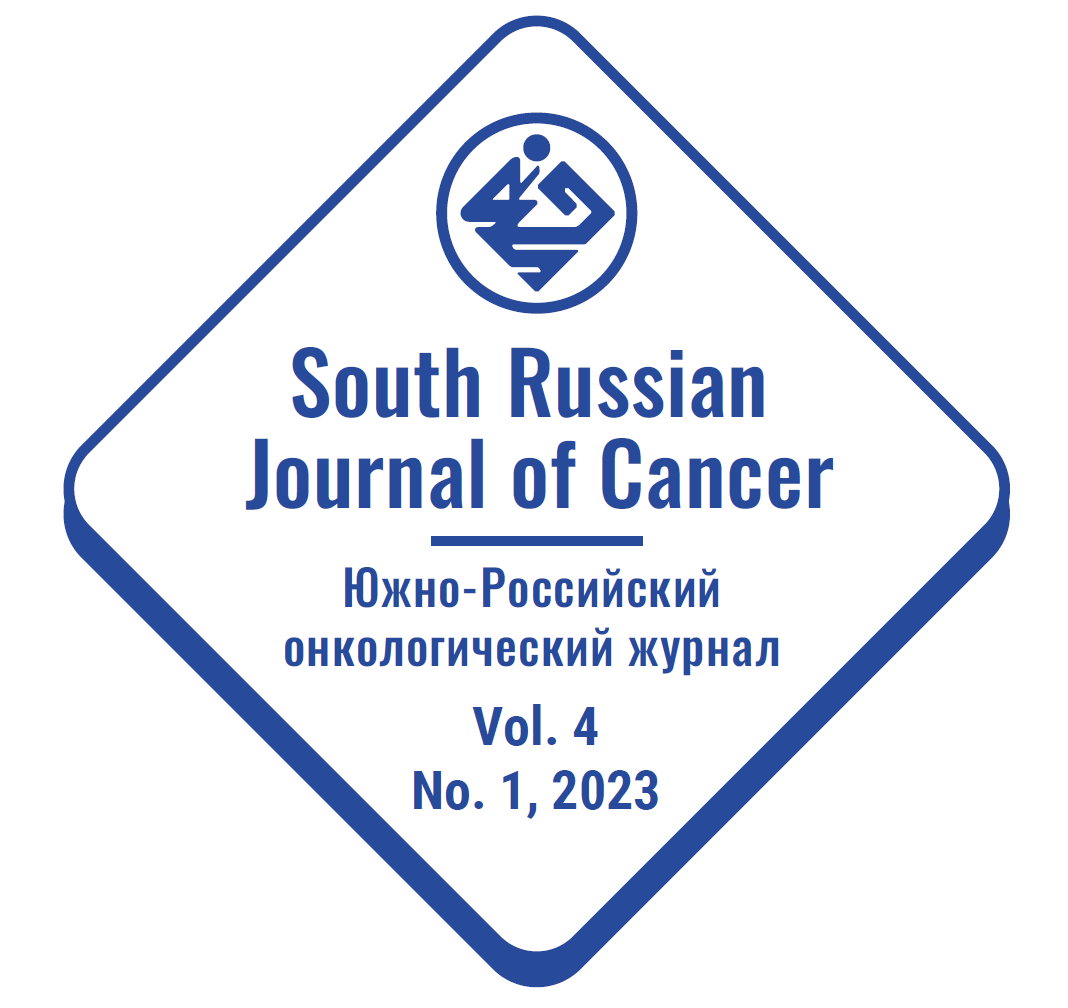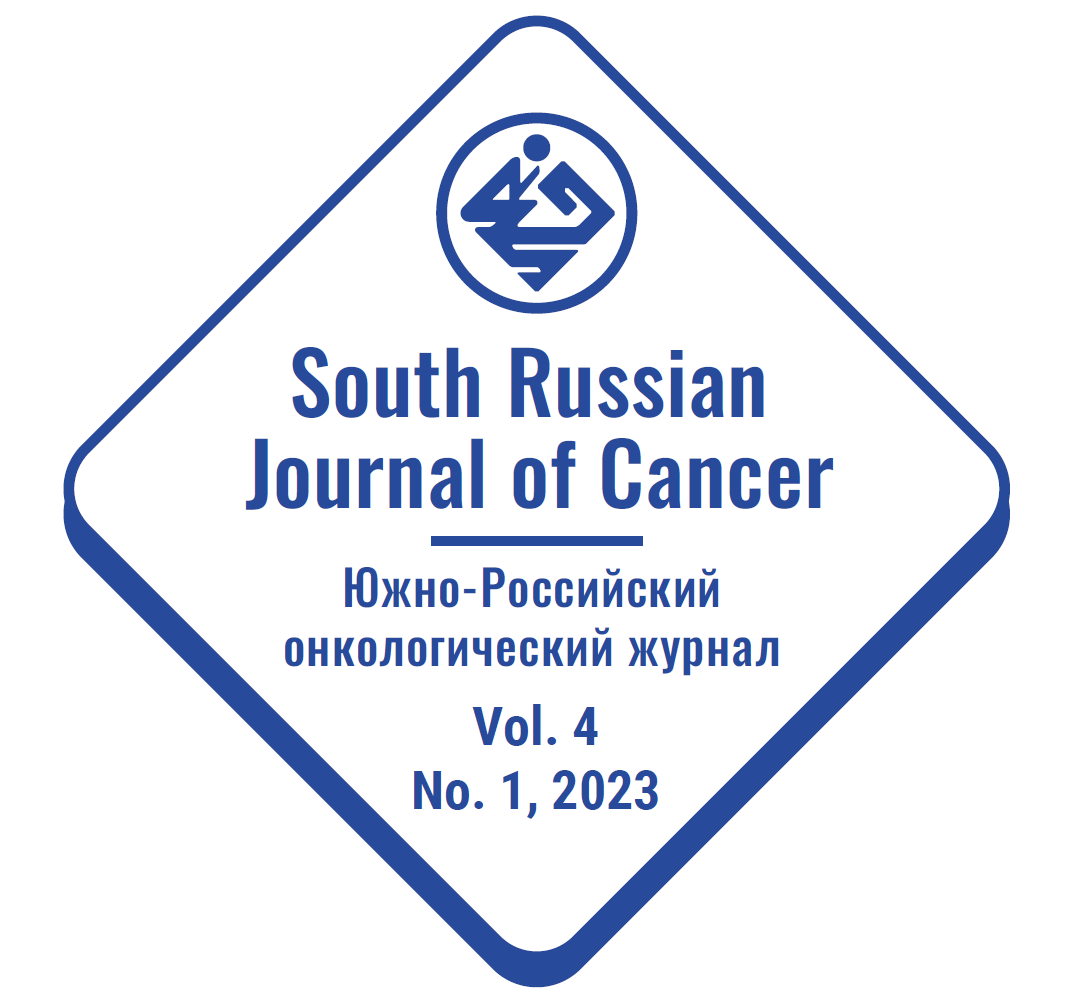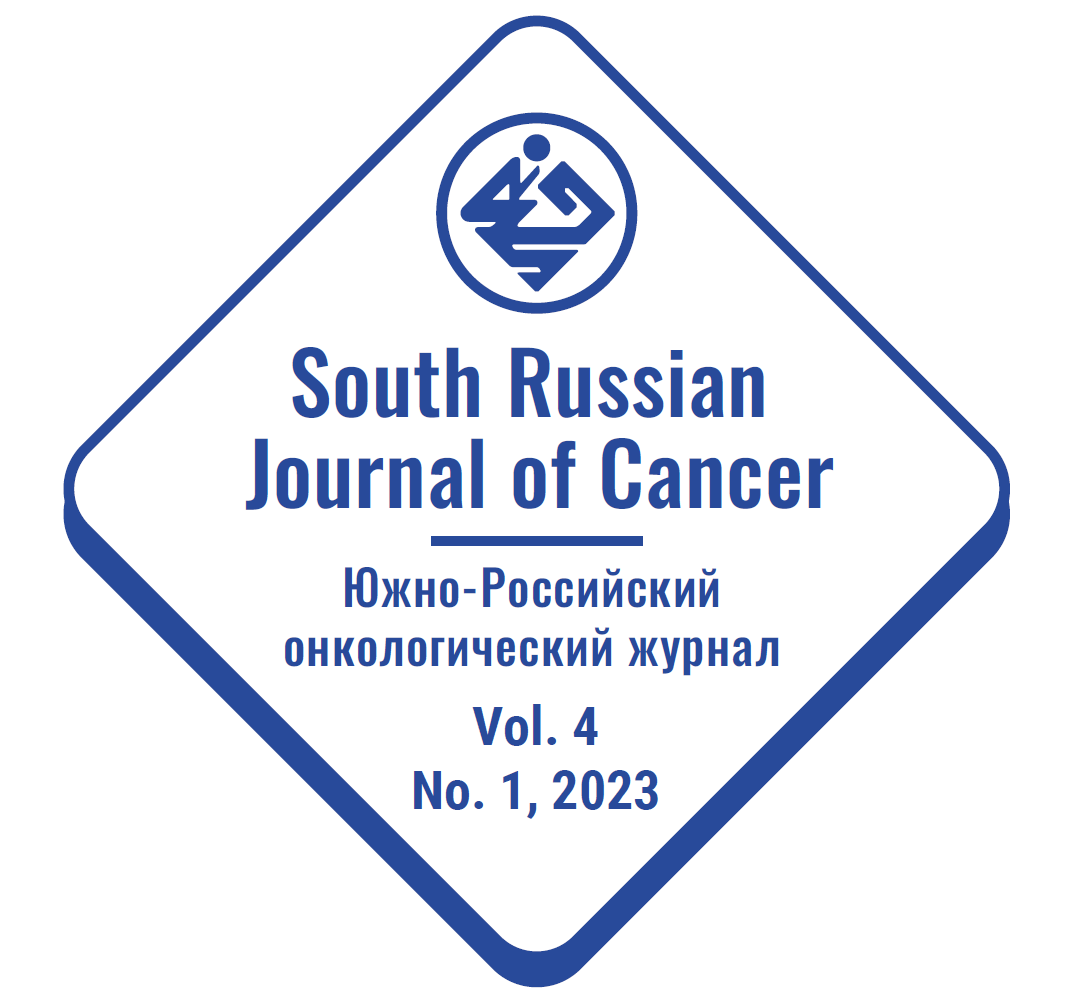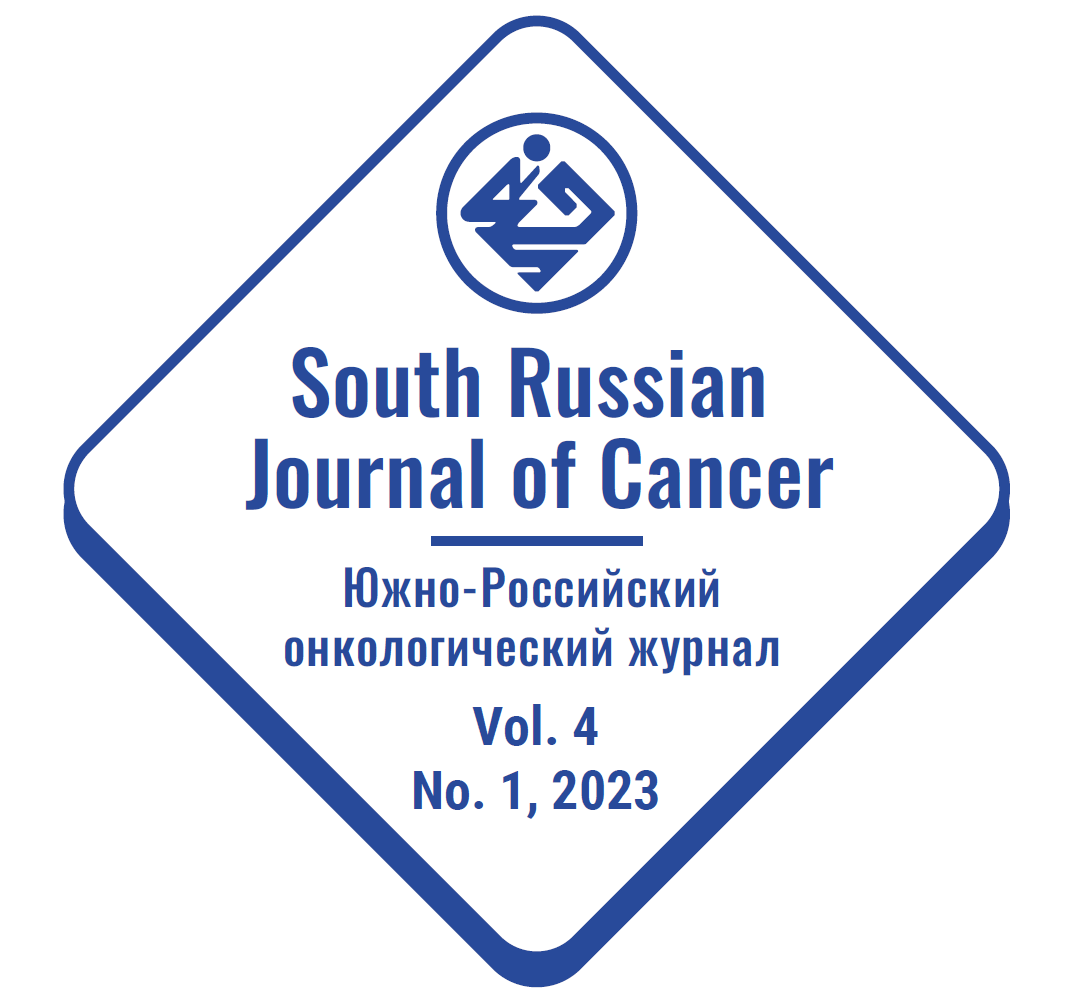ORIGINAL ARTICLES
Purpose of the study. Evaluation of the expression of immunohistochemical tumor markers Ki-67, b-catenin, Bcl-2, P53, connexin 32 and connexin 43 when using 2-(6,8-dimethyl-5-nitro-4-chloroquinoline-2-yl)-5,6,7-trichloro-1,3-tropolone in mice with xenographs of squamous cell lung cancer.
Materials and methods. Subcutaneous PDX models of human squamous cell lung cancer were created in immunodeficient BALB/c Nude mice. A fragment of the patient’s tumor (3 × 3 × 3 mm) was implanted subcutaneously in the right thigh of a previously anesthetized mouse. 200 μl of 2-(6,8-dimethyl-5-nitro-4-chloroquinoline-2-yl)-5,6,7-trichloro-1,3-tropolone was administered orally using a probe in 12 doses once every 3 days. All animals were divided into groups depending on the tropolone doses: experimental groups 2–5 with doses of 0.0055, 0.055, 0.55 and 2.75 mg/g, respectively. The control group received 1 % starch gel which was tropolone carrier. The animals were euthanized 36 days after the start of the substance administration, and the tumor tissue was isolated and prepared for the IHC study according to the standard protocol. IHC reactions were performed using antibodies for Ki-67, b-catenin, Bcl-2, P53, connexin 32 and connexin 43.
Results. Higher tropolone doses were associated with decreased expression of Ki-67, b-catenin, and the Bcl-2 protein, but increased expression of the P53 protein. The dosage of tropolone and expression of connexin 43 were directly proportional.
Conclusion. Immunohistochemical analysis of expression of proteins in PDX models of human squamous cell lung cancer when using 2-(6,8-dimethyl-5-nitro-4-chloroquinoline-2-yl)-5,6,7-trichloro-1,3-tropolone showed the changes indicating its antitumor efficacy and suggesting a possible mechanism of action based on the activation of apoptosis.
Purpose of the study. The assessment of diabetes mellitus (DM) effect on levels of sex hormones in tumor and peritumoral tissues in BALB/c Nude mice with Lewis lung carcinoma (LLC).
Materials and methods. The study included 42 male and female BALB/c Nude mice aged 8–9 weeks weighing 21–22 g. Alloxan-induced DM was reproduced in mice of the main group, and then LLC was transplanted. Levels of estrone (E1), estradiol (E2), testosterone (T), progesterone (P4) and prolactin (PRL), as well as steroid hormone receptors: estrogens (REα, REβ), androgens (RA), and progesterone (RP4) were measured by RIA and ELISA in samples of tumor and peritumoral tissues. Animals with LLC without DM were used as controls. The statistical analysis was performed using the Statistica 10 program; differences were considered significant at p < 0.05.
Results. DM in males was reproduced only after a double injection of alloxan, and was characterized by lower blood glucose levels compared to females. The growth of LLC in animals with alloxan-induced DM was possible only in female BALB/c Nude mice; in BALB/c Nude males, the tumor could not be transplanted either independently or in combination with DM. Females in the main group showed greater average tumor volumes throughout the experiment and reduced survival, compared to the control group. Tumor samples from females with LLC+DM were more saturated with sex steroids, but depleted in steroid hormone receptors, which probably contributed to the ability to avoid the body's regulatory signals.
Conclusion. The growth of LLC in presence of induced DM was sex-dependent, since the tumor could not be transplanted to male mice. DM affected the levels of sex steroids and their receptors tumor tissues in female BALB/c Nude mice.
Purpose of the study. An analysis of levels of IGF and their carrying proteins in lung tissues of cancer patients depending on the severity of the previous COVID-19 infection.
Patients and methods. The study included 60 patients with histologically verified non-small cell lung cancer (NSCLC) T1–3NхM0 receiving treatment at the Thoracic Department, National Medical Research Centre for Oncology, in 2020–2021. The control group included 30 NSCLC patients after asymptomatic or mild COVID-19 disease (15 males and 15 females); the main group included 30 (15 men and 15 women) patients after severe or moderate to severe COVID-19 infection. The mean age of patients was 59.11 ± 2.89 years; no significant differences were noted between the control and main groups. All participants gave their informed consent prior to the study approved by the Ethics Committee of National Medical Research Centre for Oncology. Qualitative assessment of IGF-I, IGF-II and IGFBP-1,2,3 levels in the tissues of the tumor, peritumoral area and resection line were measured by ELISA (Mediagnost, Germany). The statistical analysis was performed in the Statistica 10 program, the differences were considered statistically significant at p < 0.05.
Results. Regardless of the gender, levels of IGF-I and IGF-II in tumor and resection line samples in patients of the main group were higher than in the control group on average by 1.5–2.2 times, and IGFBP-1 in the tumor was lower by 1.3 times in men and by 5 times in women. The ratio of IGF and IGFBP-1-3 in patients of the control group in perifocal tissues changed towards the parameters in the tumor tissue. IGF/IGFBP-1-3 in men of the main group were lower or did not differ from the indices in the intact tissue, while in women they increased, similarly to the tumor tissue.
Conclusion. An increase in the ratio of IGF and carrier proteins in the tumor tissue of patients in the main group indicated an excessive accumulation of IGF in it, which may contribute to more aggressive growth of malignant tumors. The most pronounced disorders in the system of insulin-like growth factors were found in the tissues of the tumor and intact lung of patients with previous severe and moderate to severe COVID-19.
Purpose of the study. Was to reveal characteristics of the immunocompetent cells in colon cancer (CC) according to the disease stage, and to identify prognostic factors of cancer development.
Materials and methods. The study included 50 patients with CC: stage I – 4 patients (8 %), II – 25 (50 %), III – 21 (42 %). All patients underwent standard surgical intervention at the initial stage, the obtained material was used for subsequent studies: a cell suspension was obtained from the tumor tissue, peritumoral zone (1–3 cm from the tumor), which was treated with an antibody panel (Becton Dickinson, USA) to identify the main subpopulations of leukocytes and lymphocytes.
Results. The tumor tissues of patients with stages I + II showed a decrease in the relative number of DP, DN, NKT and CD19+, compared to peritumoral tissues, by 33 %, 42 %, 31 % and 82 % respectively. Tumor tissues of stage III patients demonstrated elevated relative numbers of CD3+, CD4+, NK by 57 %, 34 %, 48 %, and decreased DP, DN, NKT, CD19+ by 33 %, 74 %, 31 %, 59 %, compared to peritumoral tissues. DP, DN, NKT and CD19+ in the tumor decreased by 78 %, 74 %, 39 %, 60 %, respectively, and the relative number of lymphocytes increased by 138 %, compared to the tissues of the resection line. A comparative analysis of local immunological parameters in the tumor tissues of patients with СС revealed that the relative numbers of lymphocytes and CD19+ were 58 % and 87 % higher, and DP and DN were 33 % and 27 % lower in tumor tissues of stage III patients, compared to tumor tissues of stage I + II patients.
Conclusion. Thus, the obtained features of the local population and subpopulation composition of immunocompetent cells in CC, depending on the stage of the tumor process, can be used to predict the clinical course of the disease.
Purpose of the study. Dynamic assessment of the direct impact of pressurized intraperitoneal aerosol chemotherapy (PIPAC) on peritoneal carcinomatosis in ovarian cancer.
Patients and methods. The study involved 164 people with visually detectable and morphologically verified ovarian cancer with peritoneal carcinomatosis of the peritoneum (IIIb-IIIc stages of ovarian cancer). All patients underwent combined treatment of ovarian cancer, which included primary cytoreduction and 6 courses of сhemotherapy according to the TC scheme. In the main group, the standard treatment was supplemented with 3 sessions of PIPAC. Statistical processing was carried out by analyzing the exact criterion of the Wilcoxon-Mann-Whitney sums, the distribution of patients in groups by age and peritoneal lesion was estimated. It was found that the distribution of the analyzed parameters was random. The distribution in the groups by stages of the disease was homogeneous, which is justified by the use of the Barnard criterion. The dynamics of the parameters of the study was evaluated by the methods of basic statistics. Used software packages: MedCals, Statistica.
Results. The results obtained demonstrate a distinct positive dynamics in the group of patients receiving PIPAC in addition to standard treatment of newly diagnosed ovarian cancer: a significant decrease in the peritoneal cancer index, therapeutic pathomorphosis in peritoneal samples during treatment, reduction of ascites.
Conclusion. The team of authors managed to establish that PIPAC simultaneously with standard combined treatment for newly diagnosed ovarian cancer with peritoneal carcinomatosis makes it possible to achieve a dynamic regression effect of peritoneal carcinomatosis of the peritoneum, morphological regression of carcinomatosis and complete resorption of ascites in the vast majority of treated patients. The revealed therapeutic effect was prolonged and persistent with an objective assessment 6 months after the end of treatment.
REVIEWS
Glioblastoma (GBM) is the most malignant and the most common primary tumor of the central nervous system. During the last several years GBM has been classified and managed according to the World Health Organization (WHO) criteria which subdivide it into primary and secondary GBM. As it is suggested, GBM originates from glial cells and has a diffuse growth pattern, but its etiology and pathophysiology are poorly investigated up to date. Its rapid progression and anatomical location in the brain often limits the effectiveness of therapeutic interventions. Despite all scientific and technological advances, GBM remains an incurable disease with a median survival of approximately 18 months. Standard treatment options involving maximal safe resection of the tumor followed with radiotherapy and chemotherapy do not provide satisfactory Results.
Better understanding of the molecular pathology of GBM and its associated signaling pathways has opened up possibilities for new treatments for newly diagnosed and relapsing tumors. A multitargeted therapeutic approach using compounds capable of inhibiting more than one specific molecular target is a promising alternative to conventional therapies.
Currently, specialists study such innovative treatment options as small molecule inhibitors aimed at signaling pathway disruptions, immunotherapy, including checkpoint inhibitors, oncolytic vaccines, CAR T-cell therapy, and drug delivery systems. In terms of an innovative approach, the elaboration of targeted drug delivery systems is of particular interest, since this strategy looks the most promising due to its ability to increase the bioavailability and effectiveness of both standard and newly tested agents. This review discusses results of preclinical and clinical studies of innovative therapeutic approaches, their advantages and disadvantages. An interdisciplinary approach is expected to be able to combine the results of cutting-edge research in this area and to provide novel promising therapeutic strategies for patients with GBM.
Gastric cancer is one of the most widespread cancers and makes a significant contribution to the global mortality rate from malignant neoplasms. The late onset of clinical symptoms is the main reason why the disease is often diagnosed at an advanced stage, and this limits the available therapeutic approaches. Despite the fact, that extensive studies have been carried out to identify the mechanisms and markers of the development and progression of the disease, their results are currently not fully included in clinical practice. As a consequence, only marginal improvement in long-term survival has been achieved and patient prognosis remains poor. Understanding the molecular genetic features of gastric malignant tumors can provide insight into their pathogenesis, help identify new biomarkers for prognosis and diagnosis, and identify new therapeutic targets. In recent decades, advances in high throughput sequencing technologies have improved understanding of the molecular genetic aspects of gastric cancer. This review considers molecular level changes, including information on tumor suppressor genes, oncogenes, cell cycle and apoptosis regulators, cell adhesion molecules, loss of heterozygosity, micro-satellite instability and epigenetic aberrations (change in methylation level and modification of histones). The review is also devoted to the molecular aspects of pathogenesis – changes in the signaling pathways involved in the gastric cancer development; the classification of sporadic and hereditary gastric cancer at the molecular genetic level is considered. The characteristics and classification of GC presented in this review at the genetic and epigenetic levels confirms that this disease is heterogeneous. These data can be used both to develop and test potential markers and new targeted therapeutic approaches.
Lung resection is the main diagnostic and therapeutic surgical intervention in terms of lung cancer management. Air leak through pleural drains often occurs after lung resections due to damage to the pulmonary parenchyma. Therefore, proper drainage of the pleural cavity is very important for the successful outcome of the operation. The installation of a single pleural drainage after anatomical resection, the refusal to use vacuum aspiration and the earliest possible removal of drains contribute to the rapid activation of patients in the postoperative period. Prolonged air leakage (PAL) after lung resection, on average, develops in 15 % of lung cancer patients, remaining one of the most common complications adversely affecting the rehabilitation of patients and leading to delayed discharge from the hospital. The incidence of empyema with prolonged air leakage is 10.4 % with air discharge for more than 7 days compared to 1 % with air leaks less than or equal to 7 days. PAL requires prolonged drainage of the pleural cavity, which increases postoperative pain, causing shallow breathing, difficulty coughing leads to an increased risk of pneumonia, decreased mobility is accompanied by a high risk of thromboembolic complications. In addition, the treatment of complications is associated with the need to perform additional invasive interventions such as chemical or mechanical pleurodesis. Prolonged air leakage is associated with an increase in hospital mortality. Patients with an air leak have a 3.4 times greater risk of death than patients without it. Active tactics in relation to PAL include preoperative prediction of a high risk of complications, intraoperative measures to prevent air leak from the lung parenchyma and postoperative treatment to reduce the duration of PAL. The urgency of the problem is due to the fact that prolonged air leakage in patients with lung cancer after organ-preserving operations is associated with an increased risk of infectious complications due to the need for prolonged drainage of the pleural cavity. In this review, the main attention is paid to two components of postoperative management of PAL: diagnosis with an accurate assessment of the intensity of air leak and treatment of alveolar-pleural fistulas.
REVIEW OF THE MONOGRAPH
The second part of a three-component work on gen- eral carcinogenesis has been published. The first part (2021) deploys modern theories, models of general carcinogenesis: mutation theory, models of genomic instability, Darwinian and non-genotoxic models, and also explains the roles of inflammation, immunological devi- ations and tumor microenvironment in carcinogenesis.



